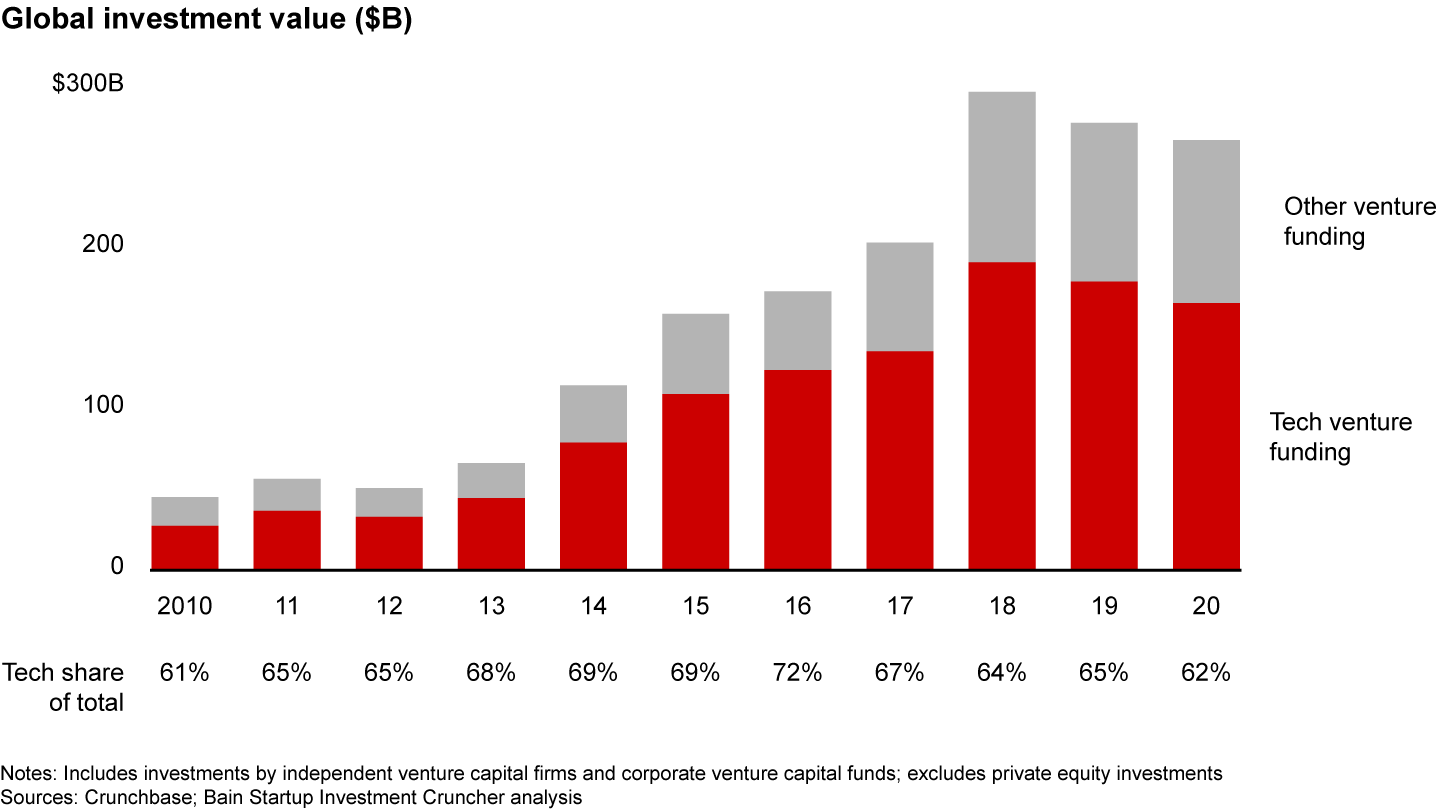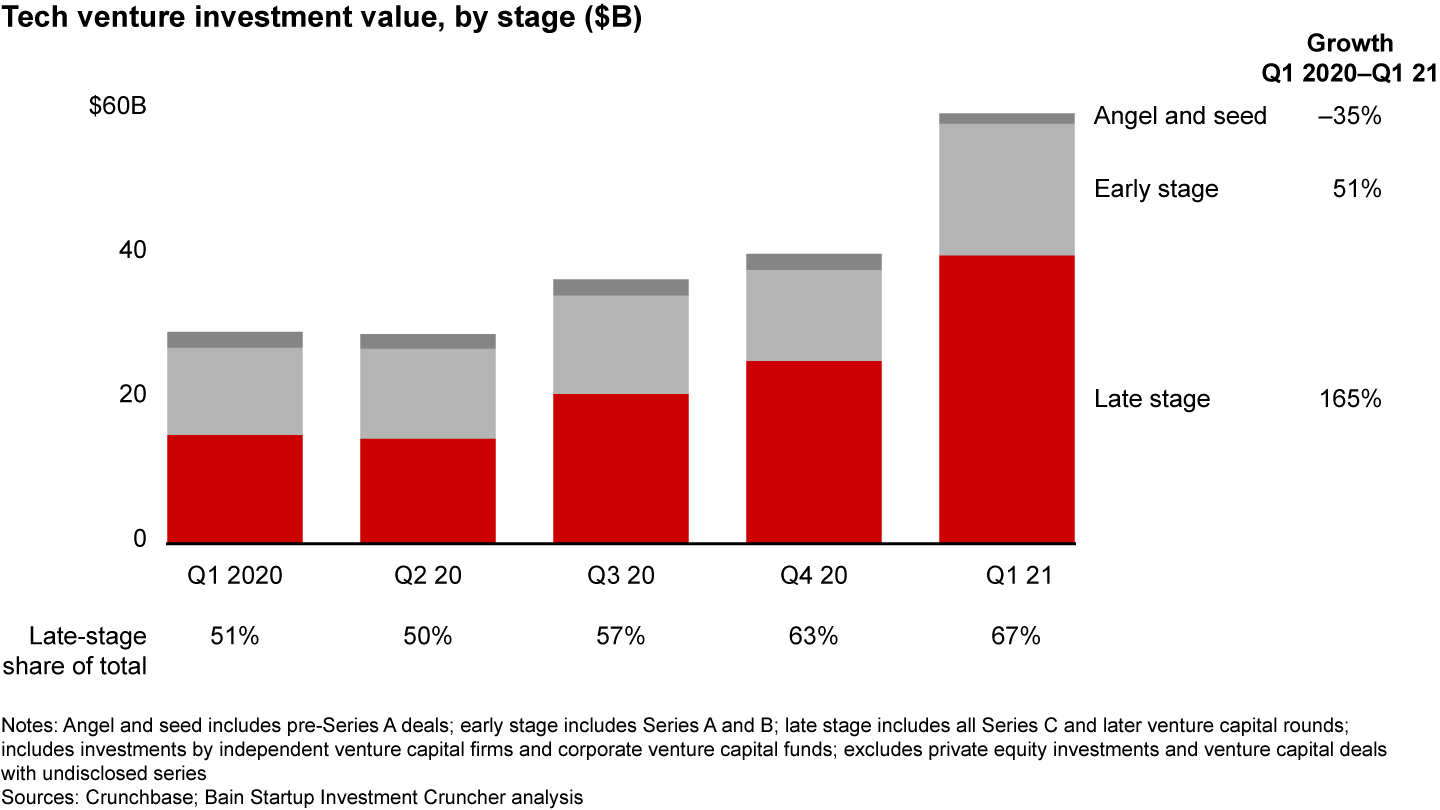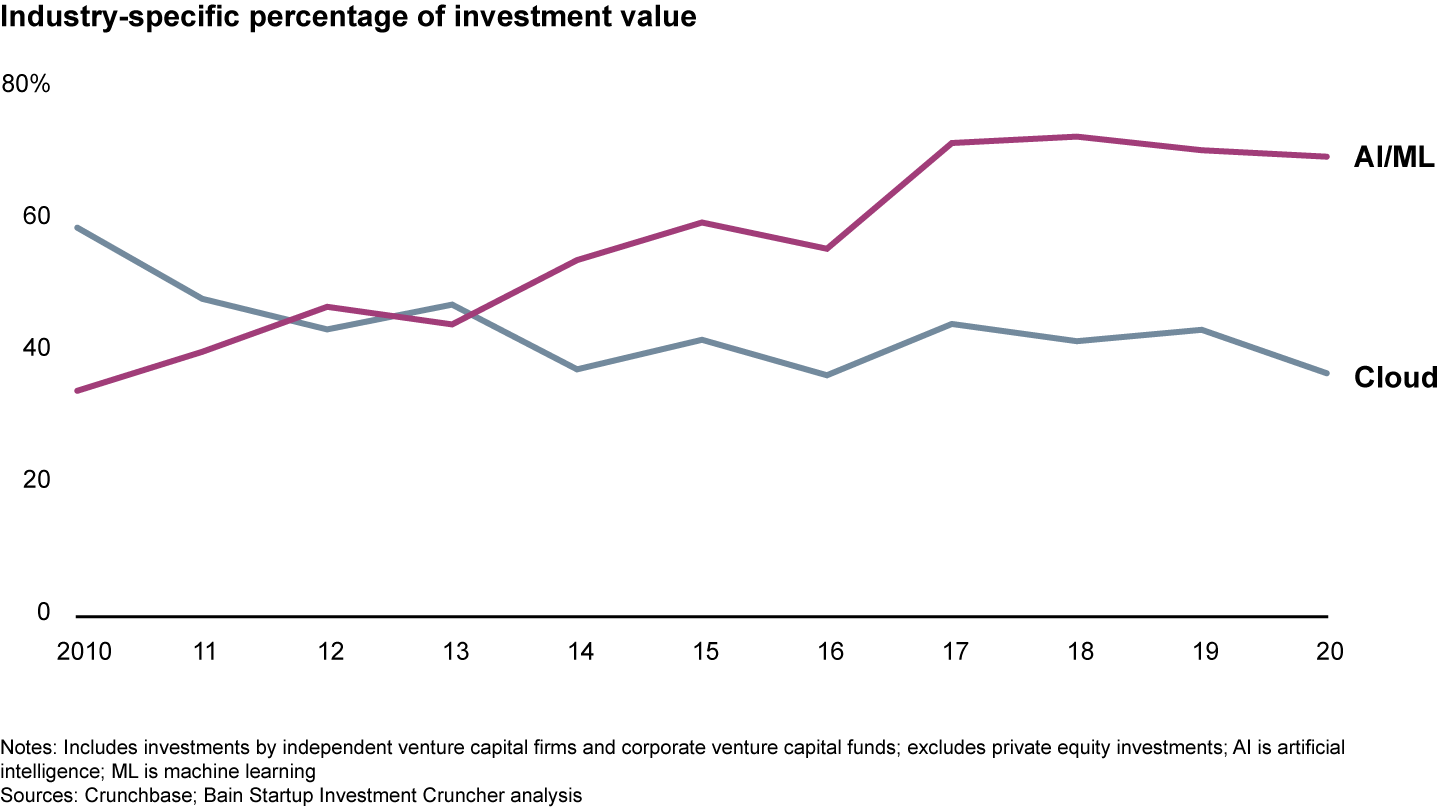Report
 }
}
This article is part of Bain's 2021 Technology Report.
Technology is reshaping the economy, and it starts with venture capital.
Technology was a driving force behind the boom in venture investments over the past decade. From 2010 through 2020, tech start-ups made up a majority of venture funding across all deals by independent venture capital (VC) firms and corporate venture capitalists, according to Bain analysis using our Startup Investment Cruncher database (see Figure 1).


Although the total value of venture investments in tech declined 13% from 2018 through 2020 amid an overall venture funding pullback—the first decline since 2012—tech venture investments came roaring back during the Covid-19 pandemic. We’ve seen a clear trend toward technology companies capturing a growing share of venture funding recently. The total value of venture investments in technology in the first quarter of 2021 nearly doubled from the same period in 2020, more than twice the growth rate of other sectors. Tech start-ups accounted for nearly 70% of total venture investments in the first quarter of this year.
The pandemic fueled this growth by accelerating the shift toward later-stage deals that had been underway for several years. The total value of tech deals in the Series C stage or later ballooned 165% year-over-year in the first quarter of 2021 (see Figure 2).


Investors have flocked toward surer bets to hedge risk and ride out the storm. But we expect this preference for later-stage rounds to continue after the pandemic. Venture-backed companies are choosing to stay private longer, which allows them to continue investing in revenue growth by avoiding capital market pressure to focus on profitability. We also see this with moonshot innovations, such as self-driving car companies, which require expensive, long-lasting development cycles. The result is growing competition for late-stage deals, which is creating opportunities for larger-sized funds and blurring the lines between traditional venture capital and private equity.
Where are venture investors focusing their technology bets? The two segments generating the most interest right now are artificial intelligence (AI) and cloud technology, which together grew more than twice as fast as venture investments in all other sectors over the past decade and now make up more than a third of total tech venture investment value.
Venture investors’ divergent approaches to investing in these two critical sectors symbolize the way they’ve evolved (see Figure 3). In AI and machine learning (ML), most venture investors now prefer to bet on start-ups developing products customized to specific industries. This signals that investors and entrepreneurs have moved beyond the starry-eyed stage of pursuing a generalized AI algorithm to solve broad problems, and now they’re taking a more stepwise innovation path with clearer payback opportunities.
The story is different in the cloud. Over the past decade, investors have increasingly placed bets on start-ups with a “horizontal,” or cross-industry, focus. During that time, venture investments have grown nearly 30% across both horizontal software-as-a-service (SaaS) applications (business intelligence, enterprise resource planning, productivity tools), and horizontal technologies that enable cloud solutions (data transfer, container frameworks, security, cloud orchestration products).
Venture investors’ horizontal inclination is no surprise in either cloud segment. Enterprises across industries are adopting SaaS tools to modernize operations and gain an edge. That trend has only picked up momentum during the pandemic. More than 20% of enterprises have increased their use of horizontal SaaS tools, according to a 2021 Bain IT spending survey of nearly 200 CIOs in North America and Europe. And the increased investments in horizontal cloud enablers reflects the pursuit of a seamless, multicloud infrastructure layer to bring about the hybrid cloud future desired by CIOs. The ability to seamlessly allocate workloads across different computing environments is becoming more urgent as many enterprises boost their spending on edge computing and the Internet of Things.


Looking more closely at AI/ML, the vast majority of venture investments are concentrated in two countries: the US and China (see Figure 4). Given the dramatic decrease in foreign direct investment between these two nations in recent years, we may be witnessing the formation of two competing ecosystems around this strategically important technology. Several patterns have emerged in this race.
The two sectors receiving the most AI/ML venture funding, transportation and healthcare, are fragmented, each with more than a dozen well-funded contenders in the US and China. In transportation, this results from long development cycles for autonomous driving, and different dynamics for robo-taxis and long-haul trucking create room for regional champions. In healthcare, venture investors anticipate winners in segments ranging from drug discovery to AI-supported diagnostics and imaging.
The fact that social media platforms ByteDance and Kuaishou are the two biggest venture capital bets on Chinese AI/ML companies over the past decade is likely a by-product of the earlier ascendency of US social media companies. Investors look to precedents like Facebook and understand the network effects and outsized returns that can result from achieving massive scale.
Three ways corporate investors can win
What does all this mean for mature corporations attempting to use the venture-funded start-up ecosystem to build their business?
There’s no shortage of opportunities to invest, but increasing competition and rising deal prices increase the odds of missteps. In addition, the many fragmented sectors in AI/ML and subsegments of horizontally focused cloud technologies makes it even more critical for investors to understand the diverse landscape of start-ups and technologies. We’ve identified a few opportunities for corporate investors to differentiate themselves in this environment.
Become a customer or partner. Leading corporate venture capitalists (VCs) don’t just invest in start-ups—they often buy their products or services, or form strategic partnerships with them. This is one area where corporate investors can gain an edge against traditional VC firms, which don’t always have a clear use for their portfolio companies’ products. By becoming a customer or partner of the start-up first, the mature firm can lay the groundwork for a future investment by testing the earlier-stage company’s technology and getting to know its team.
Be clear about your parenting advantage. The best corporate VCs not only have a clear deal thesis that fits the business’s overall growth strategy. The deal thesis should also entice start-up founders by articulating the benefits of an investment from a corporate VC, such as access to the larger firm’s go-to-market capabilities and technical talent. This can give corporate VCs a leg up over pure financial investors.
Build a targeted portfolio. Corporate VC leaders may want to believe they can make rifle-shot investments that dramatically outperform the industry standard, but this approach often backfires. Many larger corporate investors make the mistake of betting on a start-up without thoroughly screening a healthy number of investment candidates. Effective venture capital firms typically screen at least 20 start-ups before making the first investment in a target field. With every new meeting, they go back and revise their investment thesis based on what they’ve learned. Then, they make multiple investments, selecting the companies that best fit their strategy.
There’s no getting around the fact that venture investing can be difficult for large corporations because they don’t have the same risk tolerance as independent VC firms. Leading corporate VCs have found a way to comfortably act more like traditional VCs, but it may require modifications both to their organizational payment structure (to better attract and retain venture investor talent) and to the company’s governance guard rails around tolerance for failed start-up investments. The stakes have never been higher for corporate VCs to get that balance right.